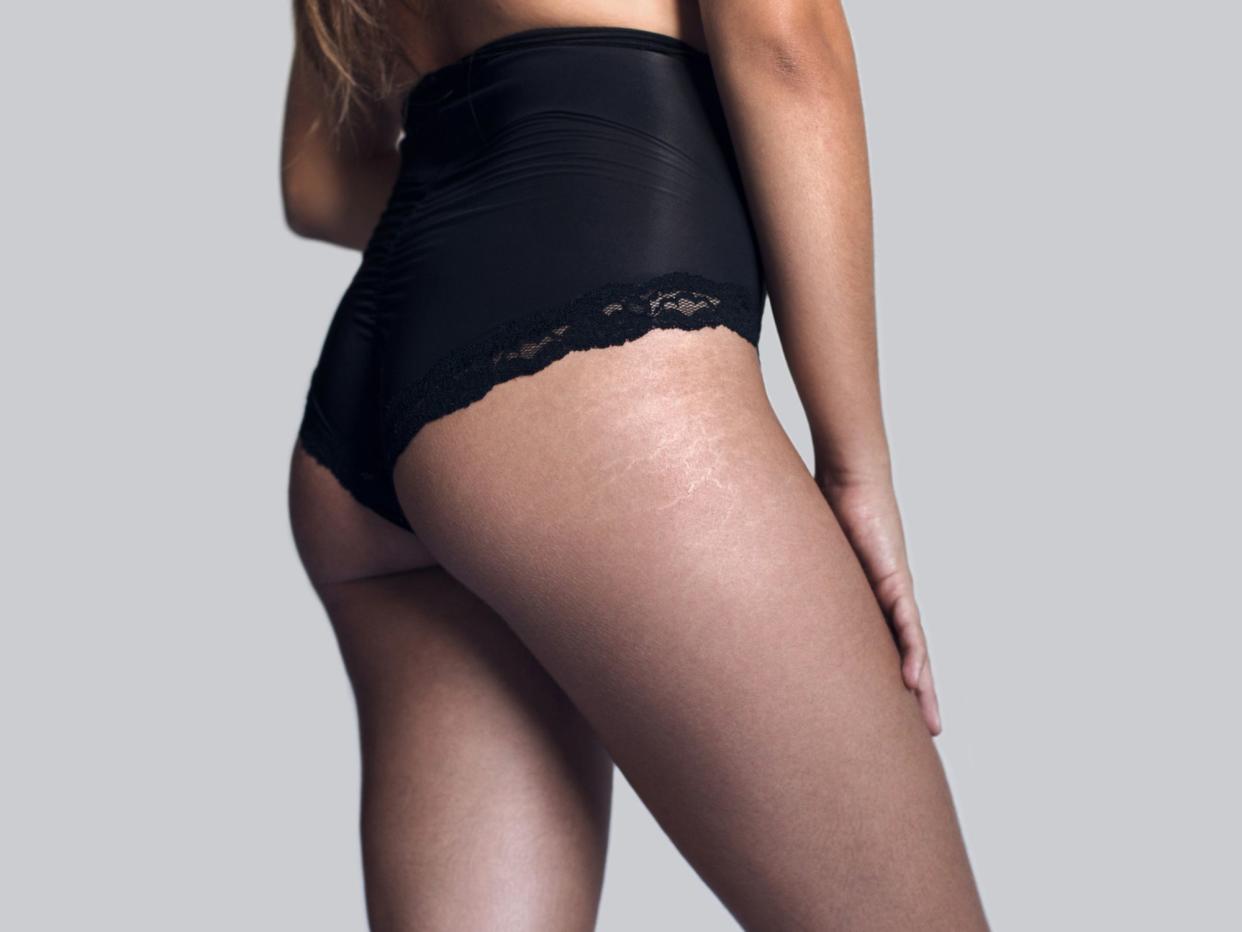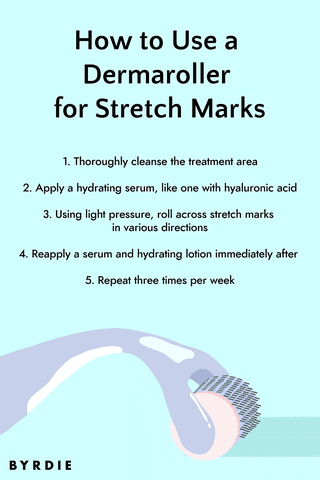I Tried Derma-Rolling for Stretch Marks—Here's What Happened

Stocksy
Fact checked by Anna HarrisReviewed by Lucy Chen, MD
Stretch marks are nothing to be ashamed of; if you go to any beach or pool, you'll likely see lots of ladies sporting their stripes in swimwear. Now, whether they fully accept them is another story, but it's comforting to see other people who are putting their marks on display. That's why it has been so gratifying to see some brands stop Photoshopping them out of their ad campaigns and even some celebrities start to show off their own stretch marks on Instagram. This openness about stretch marks inspired our editor-in-chief to share her own experience below.
I've grown used to my stretch marks, barely noticing them when I dress or undress, and the shame that came with them during my teenage years has generally subsided. I like my body, and I'm not worried about the stigma still attached to stretch marks. That being said, feeling compassion toward your body (all its curves and edges) and wanting to reduce the appearance of stretch marks don't have to be conflicting schools of thought. I can feel good about my body positivity and still try to treat my stretch marks if I so choose. So that's exactly what I did: derma-rolled my stretch marks in the hopes that they'd lighten up. Keep reading for my results along with what dermatologists have to say about derma-rolling stretch marks.
Meet the Experts
Scott Wells, MD is a New York-based plastic surgeon and cosmetic dermatologist.
Sejal Shah, MD, FAAD is a board-certified dermatologist and the founder of New York's SmarterSkin Dermatology.
James Kilgour, MD, is the Founder of KilgourMD and a Stanford University Resident Dermatologist
What Is Derma-Rolling?
"Derma-rolling is a type of micro-needling that is designed for home use. It essentially uses small, miniature sub-millimeter needles, attached to a rolling headpiece that runs over the skin, causing many microscopic puncture marks," explains dermatologist, James Kilgour, MD. To complete this treatment, you need a derma-roller, which is a tool that features many tiny needles. Those needles cause micro-injuries, and in turn, send collagen and elastin production into overdrive to promote wound-healing—leaving your skin tighter and plumper than it was beforehand. "Micro-needling is minimally invasive and effective for treating a number of cosmetic concerns, including scarring, sun damage, and wrinkles," adds Dr. Kilgour. And don't worry—it doesn't hurt. But it does resurface the top layer of your skin by encouraging your body's natural healing process.
What are Stretch Marks?
To be clear, "a stretch mark is a tear in the collagen fabric of the dermis that occurs whenever the skin is stretched beyond its tensile limits," explains plastic surgeon, Scott Wells. "This is visible as a lighter-appearing linear wrinkling under the skin. This will happen in the abdominal region during pregnancy or in the hips and leg region with rapid weight gain—this can happen any time but is most common during adolescence due to the hormonal alteration in the skin to accommodate growth."
Benefits of Derma-Rolling Stretch Marks
Enhances the texture of skin
Stimulates collagen production
Can help reduce scars and hyperpigmentation
According to the brand BeautyBio, in a consumer study, participants who used the GloPro derma-roller three times per week, 97 percent reported improvement in skin's firmness, 93 percent saw improvement in the evenness of their skin tone, and 100 percent felt it helped stimulate their skin's natural collagen after just 30 days. I liked those odds.
That being said, since my stretch marks are from years ago, they're more stubborn than newly formed ones. "New stretch marks are usually red while older ones are white," says dermatologist, Sejal Shah. "They can both be challenging to treat, but I find that newer ones are easier. While treatment options can be very effective in some, it may not be able to completely remove them regardless of whether they are old or new." I had to remember to keep my expectations in check.
How to Use a Dermaroller for Stretch Marks

Dr. Kilgour gave us all the details on how to use a derma roller safely. "Using the derma-roller is a straightforward process—but the most important step is to ensure sterility of the derma-roller head. After sanitizing both the derma-roller with a suitable disinfectant, as well as the area of your skin to be treated, the derma-roller should be gently rolled in one direction across the skin four times, lifting the head between each pass (ie. do not roll “back and forward”). After completing the four passes, repeat this process but in a perpendicular direction."
What to Expect When Derma-Rolling
I began the first session after thoroughly cleansing my skin and applying one of the GlowPro prep pads. Then I applied hyaluronic acid for some extra cushion. With gentle pressure (remember: this shouldn't hurt), I rolled the derma-roller over my inner thighs about 10 times, changing direction with each pass. I continued for a minute and watched my inner thighs turn pink and flushed from the irritation. It's normal and sounds much worse than it is. Then, I applied more hyaluronic acid serum and a firming body lotion. I went to bed anxiously awaiting my results come morning.
Byrdie Tip
It's recommended to reapply your hydrating serum and lotion within 60 seconds after the use of the derma-roller for maximum absorption.
Once the sun rose, I hopped out of bed and inspected my stretch marks. I didn't see any reduction of texture or color, but I did notice the skin on my thighs seemed tighter and more toned. The results looked exactly like they do when I use a derma-roller on my face—visible but not life-changing.
Is Derma-Rolling an Effective Treatment for Stretch Marks?
To put it simply, yes, there are studies to back up the claims, but the jury's still out on at-home treatments.
"Microneedling was studied in a published clinical trial in 2020 where 25 patients with stretchmarks were treated with a microneedling device. The patients underwent between 1-3 treatments at monthly intervals, and all treated stretch marks improved by at least 50% based on clinical assessment, says Dr. Kilgour. He goes on to add, "This research suggests that microneedling (and by extension dermarollers) could be an effective treatment for stretch marks. That being said, the microneedling device that was studied was performed by a physician in a clinical setting. In addition, the microneedling device uses an oscillating head which results in a different pattern of microtrauma to the skin. The use of an at-home derma-roller may not have the same level of efficacy—we don't know for sure as they have not been specifically studied."
The Final Takeaway
As the weeks went on, I diligently kept up this practice. I rolled three times a week for two months. After the first 30 days, I started to notice an actual difference. The silvery-white color of the stretch marks was still there, but they were no longer raised. My thighs looked far smoother than they had since puberty. I relished in the results, kept rolling away, and haven't looked back.
Read the original article on Byrdie.

